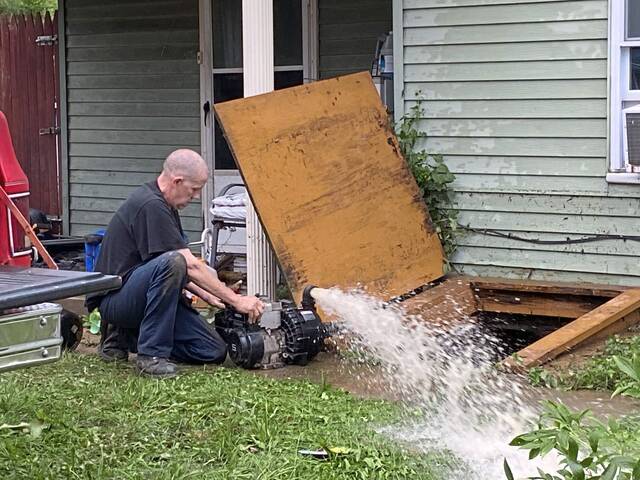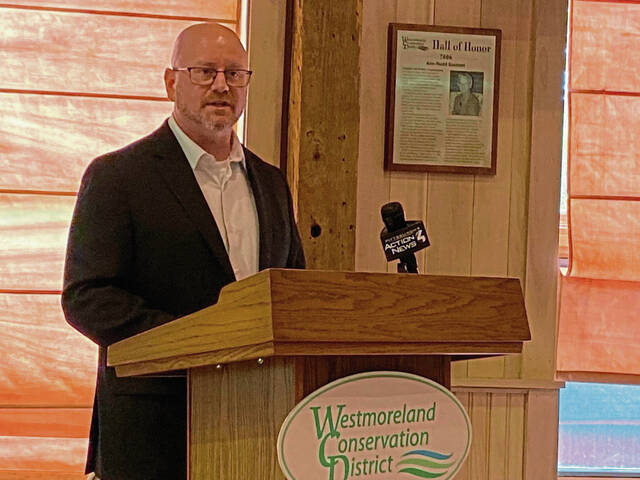Officials urge preparedness, insurance coverage in wake of Westmoreland flooding
More than 80 homes in Unity and Hempfield townships were damaged on Aug. 5 when a storm dumped 5 inches of rain on the area, causing flash flooding.
But only four of those dwellings were covered by flood insurance, according to state Rep. Eric Nelson, R-Hempfield.
That local statistic punctuated a campaign by state officials who stopped Monday in Hempfield to urge residents to be prepared for emergencies and to consider purchasing flood insurance.
Most homeowner’s insurance policies don’t cover flood damage.
“It’s a lesson you don’t want to learn at the last minute,” said Jeffrey Thomas, executive deputy director of the Pennsylvania Emergency Management Agency. He spoke at the Westmoreland Conservation District office to help promote September as National Preparedness Month.
Homes don’t have to be located in a federally designated special flood hazard area to be at risk for flooding or to be eligible for flood insurance coverage, he said.
“If it rains where you live, you should probably be thinking, ‘Should I have insurance for flooding?’” Thomas said.
He said the cost in damages is estimated at $25,000 for 1 inch of flood water rising in a home.
According to Thomas, 90% of floods tracked by the National Weather Service since 1993 have occurred outside of special flood hazard areas. Those are areas with an increased risk of flooding — a 25% chance over 30 years.
Flood risks overall are increasing, based on weather trends, he noted.
“In the last five decades, there has been a 74% percent increase in heavy rain events in the northeastern United States,” he said, referring to weather patterns that drop more than 2 inches of rain in less than two hours.
Such statistics, he said, “have us asking people to be more prepared, no matter where you live.”
National Preparedness Month was among the long-term responses to the 9/11 terrorist attacks in 2001.
Instead of an annual awareness event, Westmoreland County Public Safety Director Bud Mertz said, “I think it should be every day.”
Mertz advised residents to “understand what your risks are and make a plan around them.”
That includes preparing for a potential evacuation — whether from a flood, a tornado or a chemical spill. The Aug. 5 flash flooding affected 15 businesses as well as residential properties, he said.
Many residents were evacuated from homes in the Unity village of Dorothy, one of the hardest-hit areas in the storm.
Mertz noted the importance of keeping cell phones charged and having essential medications ready to grab and go.
Other useful contents for an emergency “go kit” include shelf-stable food, water and flashlights that have fresh batteries.
Other ways to prepare include conducting an inventory of valuable possessions and, for those who lease their home, considering renter’s insurance.
“If you have a sump pump, you may want to talk to your insurance agent about water backup coverage,” said David Buono, state deputy insurance commissioner.
In the wake of the Aug. 5 flooding, organizations including local firefighters, the Salvation Army, the University of Pittsburgh at Greensburg, The Union Mission and Catholic Charities provided help to those who were displaced or suffered losses in the disaster.
Low-interest loans also have been offered to eligible flood victims through the U.S. Small Business Administration.
Flood insurance can be purchased from private carriers or through the National Flood Insurance Program, which has information available at floodsmart.gov.
Visit insurance.pa.gov for general information on insurance in Pennsylvania and ready.pa.gov for emergency preparedness tips.
Jeff Himler is a TribLive reporter covering Greater Latrobe, Ligonier Valley, Mt. Pleasant Area and Derry Area school districts and their communities. He also reports on transportation issues. A journalist for more than three decades, he enjoys delving into local history. He can be reached at jhimler@triblive.com.
Remove the ads from your TribLIVE reading experience but still support the journalists who create the content with TribLIVE Ad-Free.




